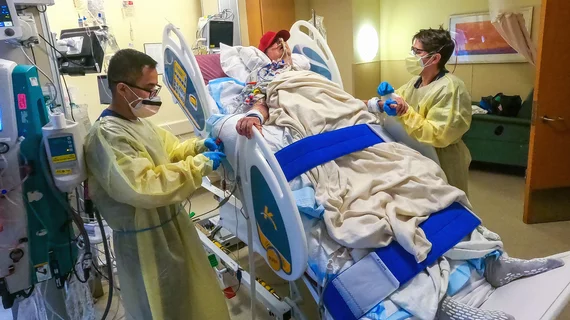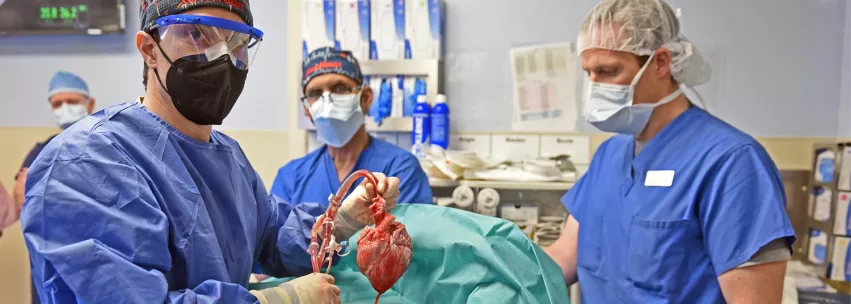ECG data from historic pig heart transplant surprise electrophysiologists
Electrocardiograms (ECGs) of the first patient to receive a genetically modified pig heart revealed some surprising findings, according to a new analysis to be presented at the American Heart Association (AHA) 2022 Scientific Sessions in Chicago.
The patient’s heart was monitored extensively with ECGs after the transplantation. The team had also evaluated ECGs of pig hearts that were still in pig bodies to improve their ability to make comparisons.
“There are several potential challenges for transplanting a pig heart into a human,” Timm Dickfeld, MD, PhD, a professor of medicine and director of electrophysiology research at the University of Maryland School of Medicine in Baltimore, said in a prepared statement. “With any transplant including this one, there is always the risk of rejection, the potential risk of infection, and a third one is abnormal heart rhythms, and that is where the ECG comes in.”
Overall, the ECG data helped researchers identify an unexpected difference between the modified heart after transplantation and an unmodified pig heart. An unmodified pig heart still in a big body is associated with a short PR interval (50 to 120 milliseconds), short QRS duration (70 to 90 milliseconds) and short QT duration (260 to 380 milliseconds). However, the first ECG of a genetically modified pig heart transplanted into a human patient revealed that the patient’s PR interval was 190 milliseconds, QRS duration was 138 milliseconds and QT duration was 538 milliseconds.
According to Dickfeld, this discovery is “truly a novel finding.”
“In a human heart, when those parameters get longer, this can indicate signs of electrical or myocardial disease,” he said. “The pig heart ECG parameters were extended to what we see in a human heart and often the measures even extended beyond what we consider normal in a human heart.”
The patient’s PR intervals remained longer as time went on, the team found. Also, the patient’s QRS duration remained prolonged, but it did shorten as more time went by.
The patient’s QT duration averaged approximately 509 seconds as time went on, and it was at its lowest on the 14th day after the transplant.
“In the human heart, the QT duration is correlated with an increased risk of abnormal heart rhythms,” Dickfeld said. “In our patient, it was concerning that the QT measure was prolonged. While we saw some fluctuations, the QT measure remained prolonged during the whole 61 days.”
Paul J. Wang, MD, director of the Stanford Cardiac Arrhythmia Service and editor-in-chief of Circulation: Arrhythmia and Electrophysiology, commented on this study’s importance in the prepared statement. He was not involved in this specific analysis.
“This was a true milestone for research on xenotransplantation, the transplantation of organs from one species to another, in this case from pigs to human,” he said. “There were a number of key steps that will be fundamental to the success of these operations largely centered around genetic manipulation to reduce organ rejection. Solving the problem of rejection may ultimately lead to use of this method to help numerous patients with advanced heart failure.”
Additional context about the pig heart transplant
The historic pig heart transplant took place on Jan. 7 at the University of Maryland Medical Center (UMMC). The patient, 57-year-old David Bennett, died on March 8, two months after the transplant.
Bennett appeared to have momentum after the procedure, the team behind the procedure shared in the New England Journal of Medicine. He was quickly weaned off of extracorporeal membrane oxygenation (ECMO), for instance, even though he needed ECMO to stay alive before receiving the new heart. UMMC even sent out a hopeful update in late February, noting that Bennett watched Super Bowl LVI between the Los Angeles Rams and Cincinnati Bengals and even sang along with “America the Beautiful.”
However, Bennett’s condition quickly took a turn for the worse. Griffith et al. have shared that the primary cause of death appears to be heart failure. They did not see any signs that Bennett’s body had rejected the genetically modified pig heart.
AHA Scientific Sessions 2022
Scientific Sessions 2022 is scheduled for Nov. 5-7. Additional details are available here. Stay tuned to Cardiovascular Business for additional coverage, including breaking news and exclusive interviews. Read through the conference’s late-breaking studies here.


